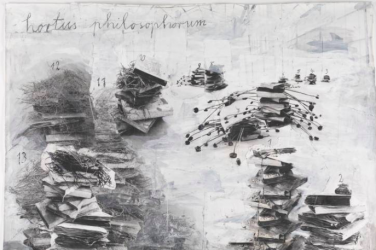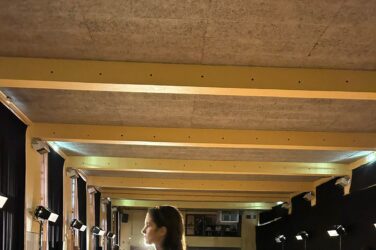Kirstine Reiner Hansen is a Danish painter based in Berlin. Salomé Melchior has conducted an interview with her in the artist’s studio in Friedrichshain-Neukölln, which is a mythical area, historically and artistically speaking. They spoke about Kirstine’s artistic techniques, vision of art, and how it feels to be a foreigner living in Berlin these days.
Kirstine Reiner Hansen’s artistic universe is a place of reverie and freedom. Her paintings echo her personality: they are subtle, thoughtful and mysterious. Even though they seem fragile at first, they reveal a silent strength. I was fortunate enough to meet her when I was in Berlin this autumn: besides her work as a painter, she gives painting lessons, one of which I took myself. She agreed to give me an interview, even though she is not one for displays of publicity, which reinforces the mystery reverberating through her way of being and painting. Sitting in her studio, learning from and talking to her, the enticing interdisciplinary aspect of her work became clear: not only does she use photoshop and derive inspiration from modern fashion, but also from masterworks of the Renaissance. Indeed, when I walked into her studio, a duplication of a Da Vinci was humbly sitting there, next to her original work.
We started off with a set of questions concerning the title of her paintings: how she chooses them, at what point, and how they may change as the artistic process unfolds.

Salomé : How do you come up with the titles of your paintings?
Kirstine: “Usually, the initial sketches and collages have a working title, often something quite straightforward like ‘gold-fish-lady’. Later, this will change to something hopefully more evocative and thought-provoking such as ‘Under The Carpet’. The final title is often decided after the painting is done. Because during the working process I might discover new meanings imbedded in the imagery, or things will be added or changed. Less often the painting has a very clear meaning right from the start, like a new painting I call ‘The Three Dis-graces’, based loosely on the classical theme of the Three Graces. Sometimes I brainstorm with my artist-husband about titles.”
Neither title nor meanings are frozen in Kirstine’s work: they are in a perpetual flux, they grow together with time, and are open to interpretation. The artist herself is open to discovery: she lets herself be surprised by new meanings that arise in her painting as she proceeds in her working process. This is representative of a sense of freedom both in Kirstine’s work and mind-set.
We then spoke about her techniques: her use of photoshop as a tool to create collages is a key part of her artistic process.
Salomé : How do you make use of collages in your work?
Kirstine: “The collages are a really important part of the process. I would say they are a way to play with the composition, with colours and to better present surprises to myself. The act of moving the cut-out elements around creates strange visuals that would have been hard to conceive of otherwise. Using photoshop as a tool is, to me, quite intuitive, as I’ve used it for years now, it’s almost like a different way of painting. I build up a multitude of layers, sometimes up to 200. It sound excessive, but they sort of grow over a longer period of time. The collage is created after I have the initial idea for the painting, which usually starts as a sketchbook drawing that is based on scribbled ideas and sentences. Sometimes, I make a drawing from the collage, to get familiarized with the new image and to work out some things before starting to paint. I also sometimes make a small oil paint sketch to work on the overall color composition before I start the larger oil paintings on canvas. All the steps allow me to contemplate the composition and its meaning over time.”
Kirstine strives to be surprised, which characterizes her, amongst other aspects, as an artist. Her work reminds one of modernism but with an ancient touch: she uses photoshop and combines this tool with romantic undertones in her paintings. The process of photoshopping some fragments of her work and using techniques of collage is a long and thought-through process that she replicates in an almost mechanical way, whilst adding to it spontaneity, a time for contemplation and potential change.
After this, we moved on to discussing her vision of ‘twin-sets’ and the way in which they appear recurrently in her work.

Salomé : You refer to a couple of your paintings as ‘twin‐sets’. Could you please elucidate this definition for us?
Kirstine: “It seems that I keep being drawn to depicting a sort of double portrait, either as one figure with several faces and limbs, or two figures that are closely intertwined. There are several meanings a theme like this can take on. It could be the psychological enmeshment of two people. It could also allude to the duality of one being. Or it could suggest the movement and action, both physically and psychologically, of taking several positions. Elements of my work are referencing renaissance paintings as well as fashion photography and advertising, and the term ’Twin-set’ refers to a type of outfit made of two parts.”
There are latent socio-political aspects to her work, which can be interpreted on a local and global scale. The protagonists of Kirstine’s paintings may seem detached from what is happening around them. She suggests that they may be indifferent to current events, indulging themselves at times into hedonism, luxury and reverie. Her work makes us question ourselves: do we blind ourselves to certain truths in order to protect ourselves, or are we self-centred enough to prioritize our well-being in the face of much bigger issues, such as global warming, for example? Kirstine’s work bears a philosophical touch since it questions ourselves and the world as a whole.
She studied design and is, therefore, to some extent an autodidact in her current professional field. So I was curious to hear about Kirstine’s artistic inspirations. We moved on to talking about cubism, romanticism, and other potential inspirations that nourish her work on a daily basis.
Salomé : I can discern recurrent shapes that come up in your paintings. It as both cubic and romantic elements, for example. Would you say you’re inspired by cubism or romanticism, amongst other potential inspirations?
Kirstine: “The modernist painters, and cubism in particular, are major inspirations. The fracturing of the image, creating movement and different viewpoints are influences for sure. I don’t think I am consciously inspired by romanticism, but I do tend to use elements of drapery and flowy fabrics, of clothing derived from renaissance paintings. Those visuals are inherently romantic, in a formal sense. I bring them in mostly because of the dimensional and almost abstract quality they add. The surrealists are a big inspiration; Magritte, Hannah Hoch, Bacon, Dali. You could say that in a sense I am sampling and synthesizing parts from art historical imagery, reconstructing something new from found pieces.”
This last statement is striking: ‘reconstructing something new from found pieces’ suggests that the artist strives to make a whole out of fragments, to merge the particular and the universal. Whilst nourishing her oeuvre with reflections on current events, and thus giving a tangible characteristic to her work, Kirstine’s paintings inhabit a surrealist leitmotiv. I am not astonished that Magritte is a source of inspiration for her. The ‘duality of one being’ that Kirstine pointed out beforehand is a Magrittean characteristic, which is anthropologically intriguing and thus inspiring.

We then turned to talk about her vision of art.
Salomé : In my point of view, your work has a poetic touch because it veils, suggests, and leaves things open to interpretation. Why do you choose to often veil faces?
Kirstine: “Nothing makes me happier than when people interpret my work in different ways, so I’m always aware of not depicting a too obvious narrative. The painterly ‘de-facing’ or veiling happens because of the need to steer the viewer’s focus away from the face and toward the rest of the action. Naturally humans are drawn to other human beings’ faces, especially the eyes. Whenever I leave too much of the facial features, the figure instantly becomes ‘someone’ instead of ‘anyone’. I guess it’s my attempt to avoid the classification of portraiture. I’d like the viewer to consider the work as a whole composition, in which every part is equally important. To do that I have to sacrifice the face to abstraction.”
Salomé : Besides the veils, grey tones are recurrent in your paintings. Is it a way of giving a melancholic touch to the people and the scenes you are depicting?
Kirstine: “Subtlety has always been a big part of my visual language. It fascinates me how a tiny detail can change a whole composition. And how subtle details influence us indirectly, even subconsciously. There is a sensitivity to greys, they can accommodate all colours and become greenish grey, purplish grey etc. So maybe in this way the grey colours allow me to express subtlety. The bright pinks and reds will not come to their full right without having a neighbouring grey colour that lets them shine.
As to the mood created of grey tones, I don’t purposely set out to create a melancholic feeling, rather I think the greys are mysterious, even unsettling. It could be that my Danish roots are showing. The Danish landscape is rich in subtle cool colours. And the Danish painter Vilhelm Hammershøi painted in almost purely monochromatic greys.
I’d like to refer to a quote by the German painter Gerhard Richter: “Gray is the colour… the most important of all… absent of opinion, nothing, neither/nor.””
Lastly, as fellow – even if maybe temporary – Berliners, we turned to talk about the curious experience that is living in this city as foreigners.
Salomé : What is your impression of Berlin as a Danish painter?
Kirstine: “After having lived away from Europe for many years, Berlin is familiar enough to feel like home and different enough to still inspire a sense of excitement and adventure. There’s a sense of freedom and tolerance here that is rare. The artist community is vast and varied, which I think is healthy. You feel that you too can belong here. Berlin has so much to offer culturally, there is always something new and cutting edge to experience, it will always inspire.”
We thank Kirstine for her time. Answers may have been edited for clarity and brevity.
Cover photo: Kirstine, courtesy of the artist










